Three Towns in Southwest Virginia Pursue Redevelopment of Blighted Buildings
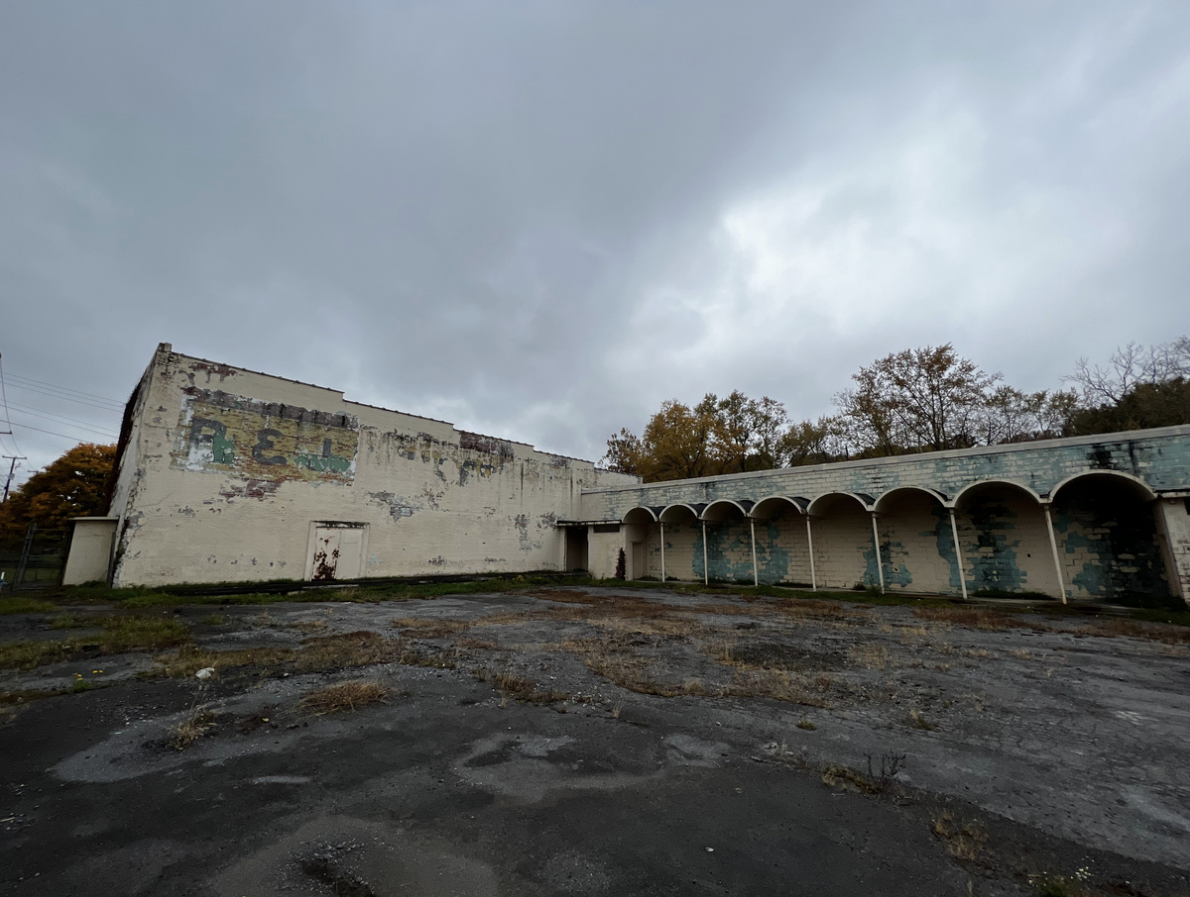
Community members are interested in redeveloping the 17,846-square-foot Cardinal Lanes building, originally built in 1947 to house an industrial and construction business called B and J Construction. Photo by Amanda Killen
By Lorelei Goff
The mayor of Tazewell, Virginia, Michael Hoops, recalls when local transportation and coal trains ran through town five or six times a day during the 1980s. The town bustled with residents and visitors.
Now, a coal train may pass through every couple of days, the population continues to decline – 3.31% since 2020 – and deteriorating, unused buildings cast a pall of blight on the north end of the town.
“If you’ve ever watched ‘The Walking Dead,’ you can probably imagine a post-apocalyptic area where the buildings are just run down,” Hoops says. “That’s our North Tazewell area.”
To change this, Tazewell – along with the Southwest Virginia towns of Pocahontas and Pound – is accessing state grants that will fund brownfield redevelopment projects.
Brownfields are properties deemed to be contaminated or hazardous and that don’t contribute to the local economy, such as historic textile mills in Hickory, North Carolina, that had contaminated materials inside them. Another example is the former RG Steel Plant in Beech Bottom, West Virginia, which was found to have asbestos in the buildings and multiple hazardous chemicals and heavy metal contaminants in the soil and water.
Brownfields grants can help towns inventory brownfield properties, assess which properties pose the biggest hazards or can potentially have the biggest impact in revitalization efforts, and assist in creating redevelopment plans.
The Hollar Hosiery Mills, Knit-Sox Knitting Mills and Moretz Mills in Hickory now house an organic, farm-to-table restaurant and an events venue, a frozen yogurt store, and a brewery, with plans for additional businesses to move in. In Beech Bottom, the remediated former steel plant site is now home to a number of industrial tenants.
Some grants are federally funded each year through the United States Environmental Protection Agency’s national Brownfields Program. The program provides various funding and grant opportunities for communities, states, tribes and others to assess, safely clean up and sustainably reuse contaminated properties. Those opportunities can change from year to year, and may vary in length from one year to multiple years.
Virginia also has a brownfield grant opportunity called the Virginia Brownfields Restoration and Economic Redevelopment Fund managed by the Virginia Economic Development Partnership in collaboration with the Virginia Department of Environmental Quality. Tazewell, Pocahontas, and Pound may all benefit from both state and federal brownfield funding.
Hoops hopes that reclaiming brownfield properties will revitalize the North Tazewell community, building on the area’s existing assets like its proximity to the Clinch River, walkability and renovated train station and visitor center, and helping to bolster the town’s fledgling tourist industry.

In the 1960s, Cardinal Lanes featured 12 lanes with automatic pins, an attached restaurant called The Bird Room, pool tables and a nursery that advertised free babysitting services. Photo courtesy of Tazewell Historical Society
Amanda Killen, New Economy program coordinator with Appalachian Voices, the organization that publishes The Appalachian Voice, assisted the town in applying for a community development block grant for the block where a former bowling alley stands. She also introduced the Tazewell Industrial Economic Development Association to the Virginia Department of Environmental Quality.
Karen Weber, brownfields coordinator for the Virginia Department of Environmental Quality, then provided the town with information related to the Virginia Brownfields Restoration and Economic Redevelopment Assistance Fund program. The Industrial Economic Development Authority subsequently applied for and was awarded an assessment and planning grant. Those funds are being used to evaluate structural conditions and the abatement of asbestos-containing materials to support redevelopment decision making.
“[Amanda] really did all the heavy lifting with all this,” Hoops says, adding, “She was instrumental in getting all the players together to start moving this forward in the right direction.”
Killen believes that brownfields redevelopment causes a ripple effect by removing barriers to make the community more attractive to developers and investors.
“Brownfields projects can be a catalyst for community development by addressing blight,” Killen says. “In each brownfield case I am working with, this has been true. Often the brownfields projects are ‘the first on the dance floor’ in revitalization efforts.”
In the case of the former Cardinal Lanes bowling alley, the Virginia Department of Environmental Quality is assisting the town to determine redevelopment options for the site, using an Environmental Protection Agency 104(k) Assessment Grant awarded to and administered by VDEQ. The grant is covering the cost of phase I and phase II environmental site assessments and planning efforts.
According to Cara Spivey with the Tazewell Industrial Economic Development Authority, Weber’s assistance has been crucial to moving forward on the project. Spivey notes that partnering with agencies and nonprofits to access grants is the secret success “so that we’re not reinventing the wheel.”
“(Weber) came and spoke to our Industrial Economic Development Authority about resources we could utilize to gather more information about this site, and how it would be free of charge to the town,” Spivey explains.
She adds, “My understanding is someone was interested in the site back in 2018 or 2019, but then they were unable to move forward with a project because of the asbestos. And so we hope that by doing this work, we’re at least mitigating some of the risk for a potential investor.”
Redevelopment also has a positive impact on residents.
“I think there’s a certain amount of discouragement that comes from just constantly seeing things fall apart or deteriorate, and not seeing revitalization and growth,” says Alicia Bales, a lifelong resident of North Tazewell. “And I think that our community — because of the wonderful community leaders and the grassroots efforts that’s happened here in our community — has turned that around.”
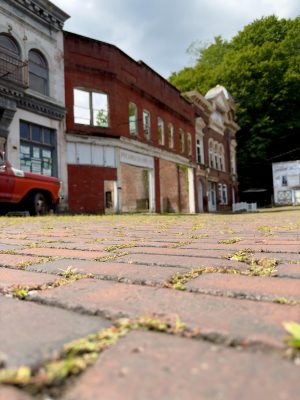
Rehabilitating brownfield properties and historic buildings, such as the Pocahontas Fire Station and opera house seen here, allow towns to improve environmental quality and economy. Photo by Amanda Killen
POCAHONTAS
Like Tazewell, the town of Pocahontas flourished when the coal industry was strong and has declined with it.
“Pocahontas is a shell of what it used to be,” says Ginger McCoy Cates, president of Historic Pocahontas Incorporated, a nonprofit organization that works to preserve the history and historical landmarks in the town. McCoy notes that the population has dwindled.
Cates and her family opened a vacation cabin rental business in the town.
“When we opened that business in 2015, we were told that we were the first new business to come into Pocahontas since the ‘50s,” Cates says.
Historic Pocahontas Incorporated has been working to preserve historic buildings for the past five years in the hope they will be stepping stones to revitalization.
“The biggest benefit to this project from my standpoint is doing the economic impact and feasibility study,” she adds.
The projects include the Pocahontas Fuel building, the adjoining coal company store property and a doctor’s office. While the fuel building has the potential for the most economic impact due to its size, Cates hopes the doctor’s office will be resurrected as a functioning medical office, something the town lacks.
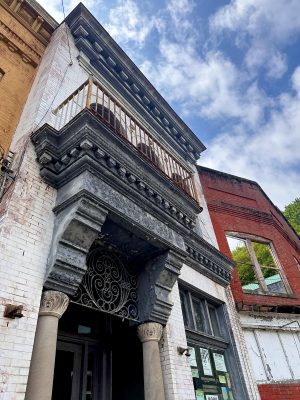
This historic building served as a doctor’s office owned by the Pocahontas Fuel operation. It is one of several Pocahontas Fuel properties being considered for revitalization through brownfield redevelopment grants. Photo by Amanda Killen
Such an ambitious vision requires a lot of money to bring to fruition – money the town of under 300 residents doesn’t have.
Fortunately, Killen and Weber know where to find it.
An EPA 104(k) Assessment and Planning Grant awarded to and administered by VDEQ is covering the cost of phase I and phase II environmental site assessments, an asbestos and lead-based paint survey and a market and feasibility study.
According to Weber, VDEQ will encourage the use of the Virginia Brownfields Restoration Economic Redevelopment Assistance Fund for asbestos and lead-based paint abatement, though there is not currently a grant in place. A later-stage effort involves concept design work that will be finalized by the Community Design Assistance Center of Virginia Tech.
POUND
Emma Kelly, New Economy field coordinator with Appalachian Voices, has been working with the town of Pound, Virginia, for about a year, providing technical assistance with grant writing, community outreach and project management. Kelly explains that the redevelopment initiative is providing much-needed technical support and guidance for addressing blight in the town and could help establish the town as a leader in redevelopment in the state.
Another partner in Pound’s redevelopment effort is West Virginia University BAD (Brownfields, Abandoned, Dilapidated) Buildings. WVU BAD, based out of the university’s Morgantown campus, provides technical assistance to communities in West Virginia to address abandoned and dilapidated buildings. Through a partnership with VDEQ, they created a new initiative to pilot the same kind of services in Virginia.
“Our model is dependent on a sort of core philosophy that communities and the priorities and direction of those communities should be built by the people who live there,” says Carrie Staton, director of WVU BAD.
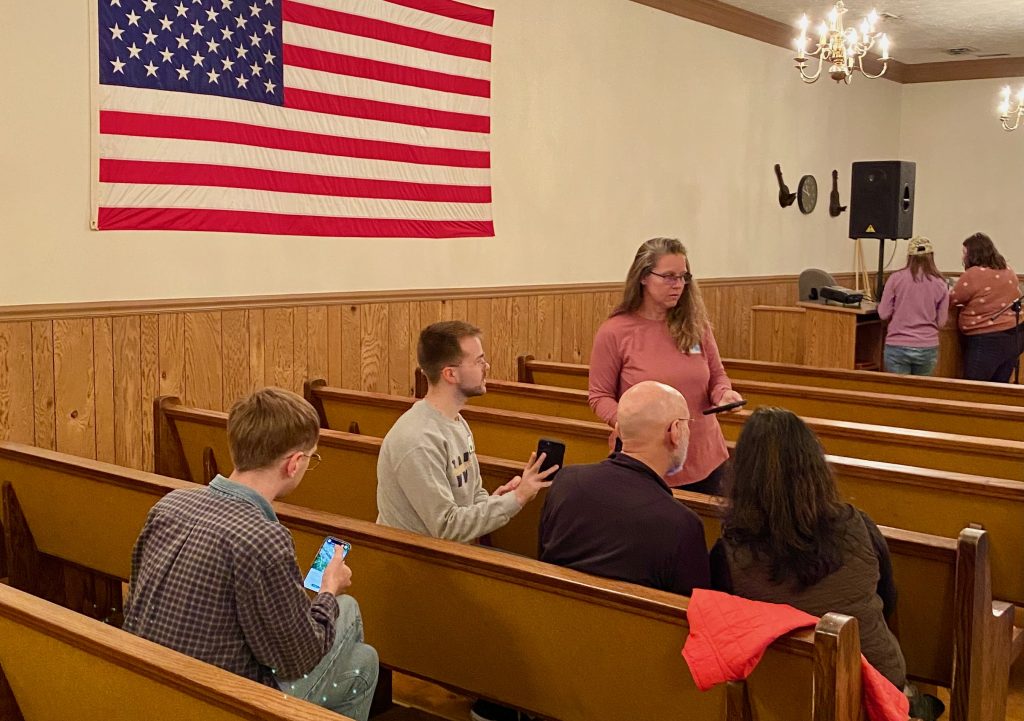
Karen Weber of the Virginia Department of Environmental Quality, standing in third row, meets with Pound, Virginia, residents who volunteered to help assess brownfield properties for possible redevelopment. Photo by Rance Garrison
On Dec. 15, 2023, Weber of VDEQ, Pound Vice-mayor Leabern Kennedy and other town representatives, Staton and staff from the WVU BAD program, and Kelly held a community volunteer day in Pound. The workshop included training for town officials and local volunteers to inventory buildings for potential redevelopment using a process called a “windshield tour” and then assisting participants in collecting inventory data.
A windshield tour is a way to evaluate a building based on what you can see from a car or sidewalk without going onto the property. The event provided valuable information about the condition of various buildings that will help determine which properties are good candidates for redevelopment grants.
Conversations in the subsequent months will look at the community’s priorities, see where the priority properties are and discuss what some strategies might be, with VDEQ and WVU BAD providing recommendations for redevelopment strategies once the process is complete.
Kennedy has worked for two years to bring a Mountain Comprehensive Health Care Corporation medical office into the town, which is scheduled to open in April. She is hopeful that an old hospital property can be redeveloped to entice a new hospital to come to town.
But her vision is broad and she sees the projects as catalysts for further revitalization.
“I think the opportunity is there to change the climate, so to speak, of our area,” Kennedy says.
Staton agrees.
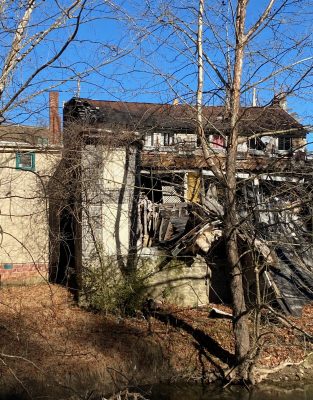
This commercial building in Pound, Virginia, previously housed businesses, including a discount store and an antique store, as well as apartments. Now, it poses a hazard to the community as it slowly collapses into the Pound River. Photo by Rance Garrison
“So what we’ve seen in a lot of communities is that nobody really knows where to start,” Staton says. “But once [a property] gets started, other people start to see either what’s possible with their property, or what’s possible with another property and how they may be able to tackle a problem that seemed insurmountable months before.
“You also, frankly, sometimes get some peer pressure, where maybe my house wasn’t the worst on the block, because there was another one that was really bad, but now that one is cleaned up and I’m the worst on the block.”
Tazewell Mayor Michael Hoops hopes successful redevelopment in his town will stem the tide of Tazewell’s youth leaving town to find better employment opportunities.
“I understand going off to college,” he says. “But I’d like for them to come back and maybe bring some good ideas to open their own businesses.”
Related Articles
Latest News
More Stories

Leave a comment
Your email address will not be published. Required fields are marked *


![“[There are] still a lot of individuals who need support, especially here in Green Cove, Whitetop, Konnarock — those are the communities up on the mountain,” says Little. “We were a part of Damascus, but because we are on the mountain outside of Damascus, a lot of the resources and help have not made their way here.” Photo by Jimmy Davidson.](https://appvoices.org/wp-content/uploads/2025/07/Virginia_Creeper_Trail_JMDavidson-32-1024x768.jpg)


I am moving to the area and am very excited to be part of this beautiful part of Virginia.
I am willing and will be involved in the public/ private sector to redevelop this amazing, historical area.
I am curious, as I cannot find any recent information on the proposed sports complex in Tazewell. Is there any update on that?
Trains may have gone through North Tazewell, but the railroad did not go through Tazewell.
Many people turn into NIMBY’s when it comes to projects like these are proposed but don’t consider what blighted buildings do to property values. Projects like this when done in a responsible and thoughtful way can add to property values, provide new tax base and keep older towns from turning into ghost towns. Rather than whining they could volunteer for committees to help steer the planning of the reclamation of the property which would bring in new business or mixed housing to distribute lower and upper cost housing. Too many places lean toward development of undeveloped property rather than look to where there is blighted spaces that could be better used. If only everyone looked to reuse of idle developed land we would be in better shape.
Sharon,
I’m not sure where the breakdown in communication has occurred, but I hope this will provide some clarification.
I am not a housing developer. I am simply a grant writer, and saw an opportunity to obtain some planning funds to hopefully be a catalyst for revitalizing the Riverside Drive area. This revitalization effort will hopefully have a positive impact on your property value, as at present the blighted buildings are doing no favors for anyone. This is simply a planning grant to provide feasibility studies for the buildings to show what they could look like and what businesses could potentially do well there with great emphasis on feedback from the community. While the agency who granted the funds is the Department of Housing and Community Development, that does not in any way mean the funds are to be used to explore any housing options. That is the same agency that funded many of our Main Street endeavors. It is a community led initiative, and we have held a series of community listening sessions so far to give everyone an opportunity to voice their ideas. There will be more community listening sessions, and we hope you all attend.
Best,
Amanda
I live within close proximity of the building in North Tazewell. It was mentioned to me, through the grapevine. That the IDA, town members, Ms. KILLEN, and others at a meeting proposed that LOW INCOME HOUSING be erected in the blanke space after the building is removed. Nothing was mentioned to the citizens in North Tazewell who leave near the building. Our administrative leaders make these decisions without informing the citizens first. I have mentioned it to several people who reside in the area, pay taxes in this area and we all agree NO LOW INCOME HOUSING IN NORTH TAZEWELL. I would like to say that if I wanted to sell my property one day, I could get a good price; however, if I had low income housing in my back door it would bring my property value down. The property values in the whole are goes down, crime goes up, it costs more to keep those areas up if the towns really take the interest to, so there are numerous reasons not to have it in your door. I work for the court systems so I know what happens. Yes the CITIZENS IN NORTH TAZEWELL, VA DO NOT WANT LOW INCOME HOUSING IN OUR AREA, IDA BOARD, AMMANDA KILLEN, MICHAEL HOOPS,AND MEMBERS OF THE TOWN COUNCIL.